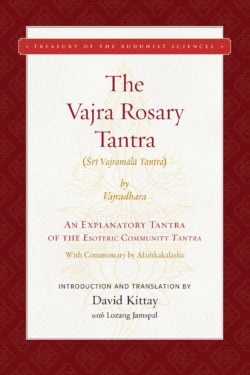David Kittay
David Kittay is an adjunct assistant professor at Columbia University in New York where he specializes in teaching courses on Buddhism and on Eastern and Western philosophy. He is the translator of The Vajra Rosary Tantra (Wisdom Publications, 2019), and several other publications about Buddhism, religion, and law. He regularly lectures at Tibet House US, where he serves on the Board, and at Do Ngak Kunphen Ling Tibetan Buddhist Center, at Columbia, and worldwide, and is the President of the Tibetan Classics Translators Guild of New York. He also writes and lectures on the subject of compassionate lawyering, and has served as a trial and civil rights lawyer, federal bankruptcy trustee and a receiver for the Securities Exchange Commission. He is currently Director and Professor of Philosophy at the Harlem Clemente Course for the Humanities, teaching humanities to economically disadvantaged people in Harlem.
Books, Courses & Podcasts
The Vajra Rosary Tantra
The Vajra Rosary Tantra (Śrī Vajramālā Vyākhyā Tantra) is one of the most significant and detailed tantras attributed to the Buddha, in his emanation as Vajradhara. It instructs a practitioner how to overcome the 108 energies and their related instinctual conceptions that circulate in the subtle body and mind and drive continued rebirth in cyclic existence, in order to attain the freedom of enlightenment. One of the explanatory tantras of the Buddhist Esoteric Community (Guhyasamāja) Tantra, its unexcelled yoga tantric system is among the most advanced systems described in Tibetan Buddhist literature. It mainly focuses on the final stage of Buddhist tantric practice, the perfection stage by means of which a person is said actually to become a buddha.
There is no more authoritative endorsement than that of the great Tibetan renaissance scholar, Lama Tsong Khapa, who strongly recommended the Vajra Rosary Tantra as follows: “Nāgārjuna, in condensing the perfection stage into the five stages, follows this tantra; he also follows it regarding the creation stage three samadhis, four yogas, thirty-two deities, and so forth. . . . It explains the many stages of creation and dissolution of the body in terms of the channel structure, wind energy movement, and enlightenment-spirit substance as a factor in the decisive ascertainment of the internal and external life-energy controls for bringing forth the four voids and the magic body, depending on . . . the hidden discipline of desire and of the vajra recitation . . . and the limitless ways for the dawning of realization. . . . It seems that such excellent elucidation is rarely seen.”

